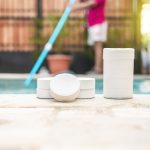The ABC’s of Algae
About Algae
Algae are one-celled non-flowering organisms, typically of aquatic plant life that shows up in your pool. Algae can reproduce rapidly by photosynthesis if all the stars are aligned changing a crystal-clear pool from blue to green in less than 24 hours. Algae needs nutrients to grow including carbon, hydrogen, oxygen, nitrogen, and phosphorous. Ironically, all of these are commonly found in the pool environment originating in the chemicals added, contaminants that enter the pool, and some from the water itself.
By Color
Typically, algae are grouped by color. The most common form of algae is green. This is the most easily controlled form. Black algae in swimming pools are found in areas of poor circulation. This is commonly seen on the corners, steps, and areas behind ladders. Yellow algae is stubborn and more difficult to treat. Yellow algae require a special algaecide that is used in conjunction with maintaining specific water chemistry parameters in order for it to be effective. There are other colored algae, but the green, black, and yellow varieties are the most common in the swimming pool environment.
Control
Since these nutrients can enter the pool in a multitude of ways, it is necessary to maintain efforts to control their presence to eliminate the potential for algae growth. As some of the nutrients exist in the water itself, it is key to be vigilant with additional control measures. One way to control these nutrients from entering the pool is by requiring users to shower before entering to remove any nutrients that may be on the person or their clothing. For the pool itself, you want to make sure you are maintaining proper water chemistry, efficient filtration, and adequate circulation to prevent algae from having the ability to grow. You also want to do a lot of brushing as algae need something to cling onto to grow and spread, so brushing the walls, tile bands, and floors is key! If you are in an area where a lot of nutrients have the chance of getting into your pool (I.e., next to a golf course or meticulously landscaped environment), you want to consider using algaecide as a preventative measure. These areas typically tend to have a lot of phosphates. Many towns are putting phosphates in the water we use to fill our pools. Phosphates are plant food for algae. Testing for and keeping phosphates below 500 ppm is another good preventative. Also, be aware that filling your pools with well water also can add unwanted nutrients that aid in algae growth.
Now You Know
Now that you know what algae is, where it comes from, how it grows, and how to prevent it, you want to enact an algae prevention plan to keep it at bay. It is much easier to prevent than treat algae, so take the necessary steps today to keep you swimming algae-free all season long!






